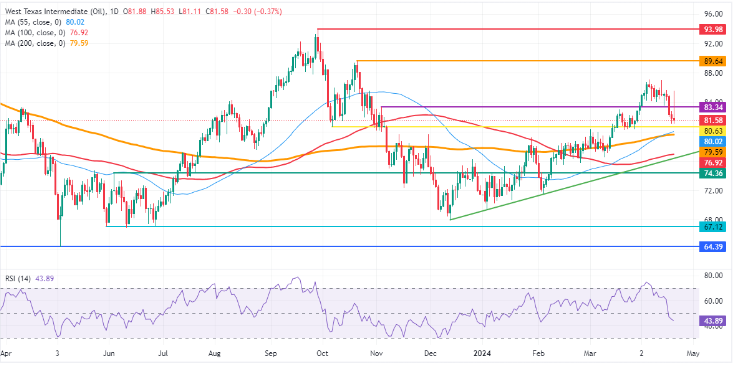- Oil prices slip into negative territory this Friday as markets shrug off Middle Eastern tensions during the APAC session.
- WTI Oil sees a pullback from $85.00, while Brent falls below $90.
- The US Dollar Index also softens, reversing earlier safe-haven inflows prompted by headlines.
Oil prices are descending further as markets reassess the situation, deeming it less risky than initially anticipated, following Israel’s retaliation against Iran by targeting locations in the Western region, as confirmed by two US officials to Bloomberg. Iran has restricted its airspace and, alongside the United Nations nuclear watchdog, affirmed that no nuclear facilities were impacted. This retaliatory strike heightens the potential for a direct confrontation between Israel and Iran after years of proxy conflict between the two.
The US Dollar is witnessing a partial retreat from earlier substantial safe-haven inflows, although the fundamental landscape remains relatively unchanged: investors continue to flock to safe-haven assets amid concerns that the attack could mark a turning point, potentially drawing the entire Middle East into the dispute. Additionally, the Greenback benefits from the recent surge in energy prices, particularly oil, which could spur secondary effects on inflation in the coming months if the situation persists. This creates scope for further interest rate hikes from the US Federal Reserve (Fed), although it remains outside the primary scenario for nearly all Fed members.
WTI Crude is trading at $81.64, while Brent Crude stands at $86.03 at the time of writing.
Oil news and market movers: Everybody happy
- Iranian state media reported that an attempted Israeli drone attack failed, and according to a senior Iranian official cited by Reuters, Iran currently has no immediate plans to retaliate against Israel. However, the question remains: when might such retaliation occur?
- Stephen Dainton, head of investment bank management at Barclays, suggested to Bloomberg that the decline in oil prices may be occurring this Friday as markets digest the news. Nonetheless, he anticipates that oil will trade within a higher range going forward and may not drop below $80 in the near future.
- Reuters reported that the US Embassy in Jerusalem has issued a security alert for government officials and their families. Iran’s communication via state television appears to be downplaying the situation, characterizing the attacks as minor. However, The New York Times mentioned three Iranian officials stating that a military air base near Isfahan was indeed targeted.
- Meanwhile, Israeli Prime Minister Benjamin Netanyahu faces criticism from his National Security Minister Itamar Ben Gvir, who labeled the attack as “weak” in a tweet.
Oil Technical Analysis: All done for now
Oil prices surged over 4% in early morning trading on Friday fueled by headlines from the Middle East, only to sharply decline into the red as the US session began. Expectations suggest some moderation throughout the day as markets assume Israel’s response was contained and anticipate Iran maintaining composure without immediate retaliation. However, market sensitivity to headlines is likely to persist until Iran issues an official statement.
Amid lingering geopolitical tensions, the price levels of $83.34 and $90 remain within reach. One obstacle along the way is the $89.64 peak from October 20. Should tensions escalate further, September’s peak at $94 could come into play, potentially leading to a fresh 18-month high.
On the downside, $80.63 emerges as a pivotal support level. Slightly softer support lies at the convergence of the 55-day and the 200-day Simple Moving Averages (SMAs) at $79.88 and $79.57, likely to impede any further downward movement.

